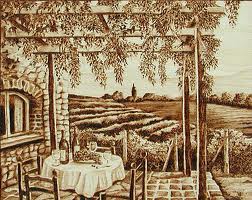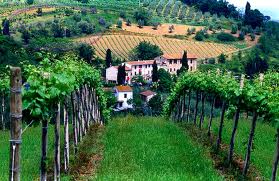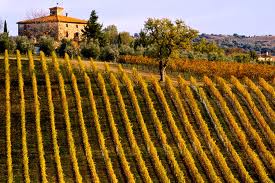 Italy: the land of art, architecture and ancient culture, poetry, pasta and wine; of long, lazy, summer lunches at rough wooden tables strewn with wine bottles and the detritus of a simple feast; of broad, shady terraces overlooking vine-draped hills speckled with rustic farmhouses and campanile, olive groves and terracotta roof tiles…
Italy: the land of art, architecture and ancient culture, poetry, pasta and wine; of long, lazy, summer lunches at rough wooden tables strewn with wine bottles and the detritus of a simple feast; of broad, shady terraces overlooking vine-draped hills speckled with rustic farmhouses and campanile, olive groves and terracotta roof tiles…
Last month, unable to realize that particular dream on the spur of the moment, I did the next best thing, and spent an evening in the company of a number of interesting Italian wines that have relocated to Manila with the assistance of entrepreneur Nick Lapthorne and his partner, Martino Feltrin.
Together Nick and Martino aredeveloping Arena Wines, importing a portfolio of fine Italian wines including the popular Barolo, Valpolicello, Pinot Grigio, and Moscato styles and the lesser known Sicilian, D’avolo Nero.
Before we went, I did a little preliminary research, and found the Arena Wines website. An arena is not only a sports venue, but a sphere of interest, activity, or knowledge and, as I am interested in the activity of drinking wine, and in knowing more about it, I felt I was in the right place.
Like the language of wine, the Arena website has floral overtones:
“Our goal is to spread the fruit of our tradition and the perfection achieved with innovation and commitment by producers who work with the passion of real artists…”
And it seems they hope to spread the gospel of St Vincent, Patron Saint of Wine, to the Filipinos in particular. As the demand for wine grows here in Manila, Arena Wine is striving to make its mark. Quickly realizing there was a gap in the market for Italian wines, Nick’s Italian partner Martino was charged with hand picking a selection of wines from his homeland. Notably a sweeter selection than might be chosen for Australian drinkers, Martino has created a substantial wine list to introduce Filipinos to the joy of Italian varieties, and “to promote the Italian wine culture and lifestyle,” with wines from six major wine making regions: Piedmont, Alto Adige, Fruili and the Veneto in the north, Tuscany in the centre, and Sicily on the southern tip.
The Arya Showroom was not easy to find in the onslaught of a tropical storm. The invitation suggested ‘The more wine lovers the merrier!’ and after several u-turns and wrong turns, and a visit to the McDonalds drive-thru, we eventually joined the gathering throng of courageous souls who figured free wine was worth the risk of a little wet shoe leather.
The company wine list runs to pages. Sadly, only fifteen wines were available for  tasting, but that was probably enough for ne evening, and we tried them all, red, white, sweet and sparkling, with mixed responses. Like many Filipinos, I am unfamiliar with the nomenclature of Italian wines. Australia is slowly making a foray into Italian grape varieties – a sensible venture in my opinion, as the climate, particularly in the south, is so similar to that of Italy – and I am vaguely familiar with Chianti, Pinot Grigio and Valpolicella. I had never heard of many of the others: Ribollo Gialla, Barbera, Garganega and Grillo Parlante were all new to me. I certainly had no expectations of flavour, aroma, typicity or tanins I would be trying.
tasting, but that was probably enough for ne evening, and we tried them all, red, white, sweet and sparkling, with mixed responses. Like many Filipinos, I am unfamiliar with the nomenclature of Italian wines. Australia is slowly making a foray into Italian grape varieties – a sensible venture in my opinion, as the climate, particularly in the south, is so similar to that of Italy – and I am vaguely familiar with Chianti, Pinot Grigio and Valpolicella. I had never heard of many of the others: Ribollo Gialla, Barbera, Garganega and Grillo Parlante were all new to me. I certainly had no expectations of flavour, aroma, typicity or tanins I would be trying.
My amateur opinion has always been that Italian wine is not ‘stand alone’ wine like we make in Australia, but is designed to be drunk as a condiment, or seasoning, to enhance the flavours of the food, and inevitably it works best with a bowl of pasta and a lot of sunshine. So perhaps drinking it accompanied only by a deluge of tropical rain and a few olives was a little inappropriate! Nonetheless, we had fun checking out some interesting and unfamiliar wines.
I assiduously marked each wine I tasted, beginning with one variety I was already acquainted with. Nero d’Avola is indigenous to Sicily, but has recently migrated to the Adelaide Hills, where I was delighted to discover it earlier this year. Until recently, it has been a virtual stranger internationally, but with its sweet tannins and plummy flavour, it is becoming increasingly popular.
I wasn’t enamoured of every wine we tried – a couple, to be brutal, were like chewing on Band-Aids – but there were plenty of good ones to keep us all happy. An extra dry Prosecco from Treviso, just north of Venice, was a refreshing opener that I returned to once or twice, while my friends preferred the demi-sec. And there were some interesting styles from northern Italy that I was not surprised to discover, were more German than Italian, such as the spritzy and aromatic Gewürztraminer and the Swiss Müller Thurgau popular for making white wine in Germany, Austria and Northern Italy, both varieties preferring the cooler northern climate.
 Having a personal penchant for a cold rosé on a summer afternoon, I was keen to try the award winning sparkling Filanda Rosé. Created by the women (mother and daughters) of the Bortolomiol Winery in the Veneto, near Treviso, they have dedicated this wine to the local women who worked in the silk mills. Described as ‘a homage from women to women, proudly pink with a splendid mousse,’ it is a little sweet for me, but served icy cold for a summer lunch, it would be perfectly lovely.
Having a personal penchant for a cold rosé on a summer afternoon, I was keen to try the award winning sparkling Filanda Rosé. Created by the women (mother and daughters) of the Bortolomiol Winery in the Veneto, near Treviso, they have dedicated this wine to the local women who worked in the silk mills. Described as ‘a homage from women to women, proudly pink with a splendid mousse,’ it is a little sweet for me, but served icy cold for a summer lunch, it would be perfectly lovely.
Then there was a Tuscan winery called Poliziano, of whose reds we tasted a young, fruity, full-bodied Rosso de Montepulciano DOC 2011 that probably needs translation, but you won’t get one from me! European wines have always had an elitist language all their own, that makes no sense to the uninitiated. When I have lived my dream and spent a year in Tuscany, I’ll get back to you.
In the meantime, I have a few more Italian wines to explore….
*With thanks to Google images for the photos

Pingback: Dreaming of Tuscany… | She gathers no moss | Which Wine Is Sweet